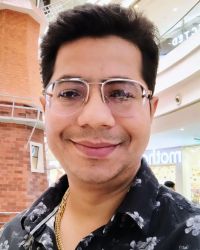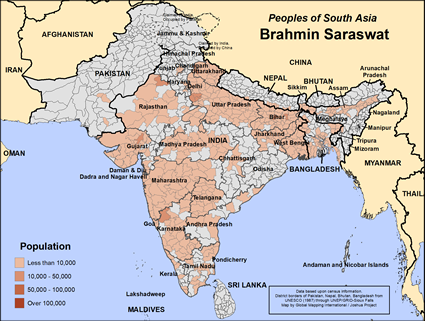Brahmin Saraswat in India

Photo Source:
Anonymous
|

Map Source:
People Group Location: Omid. Other geography / data: GMI. Map Design: Joshua Project
|
| People Name: | Brahmin Saraswat |
| Country: | India |
| 10/40 Window: | Yes |
| Population: | 609,000 |
| World Population: | 618,500 |
| Primary Language: | Hindi |
| Primary Religion: | Hinduism |
| Christian Adherents: | 0.00 % |
| Evangelicals: | 0.00 % |
| Scripture: | Complete Bible |
| Ministry Resources: | Yes |
| Jesus Film: | Yes |
| Audio Recordings: | Yes |
| People Cluster: | South Asia Forward Caste - Brahmin |
| Affinity Bloc: | South Asian Peoples |
| Progress Level: |
|
Introduction / History
Saraswat Brahmins are Brahmins who lived on the banks of the former Saraswati River that once flowed in northern India. Saraswats are considered among the oldest and most widespread community in India, still preserving their own culture. Around 1900 BC, the river Saraswati started vanishing underground and the people on its banks started migrating to other parts of India thus forming sub-communities.
What Are Their Lives Like?
Traditionally in the varna system Brahmins are considered as priests, but a temple priest is a lowly position that no Saraswat Brahmin family wants their sons to aspire towards. Rather, there is strong pressure for higher education, particularly in computer science and engineering. Saraswat Brahmins have a strong work ethic and are often leaders, whether politically, intellectually, spiritually or socially.
Saraswat Brahmins are still deeply influenced by the traditional four stages of life; the first student stage is followed by the householder stage, where marriage, raising a family and being a productive member of society is the primary obligation of an individual. Once children are married there is time for spiritual concerns in the third stage of reclusiveness, which is followed (this is rarely practiced) by itinerant homeless wandering (sannyasa).
Often a busy Saraswat Brahmin will put off spiritual discussions as an issue for later in life. The famous Bhagavad Gita text does not support this, however, as it calls for all humanity to engage in doing good to all without thought of merit or reward for such actions.
What Are Their Beliefs?
In some cases, Brahmin subgroups are defined by their theological distinctions such as Madhva Brahmins, who are defined by their dualist theology, though everyone does not actually hold those beliefs. However, many Brahmin castes are made up of people who adhere to all the various philosophical and theological options espoused by modern Hindus, including hard core secularists and atheists. One can never predict what an individual Brahmin might believe or disbelieve!
But most Brahmins respect the ancient (and many not-so-ancient) traditions of their forefathers. Some work to synthesize modern science and Hindu beliefs and practices. Few today have seriously studied, let alone memorized, the ancient Vedas; but one is more likely to find a person knowledgeable about the Vedas and other Hindu texts and teachings among Brahmins than among any non-Brahmin caste group.
What Are Their Needs?
Saraswat Brahmins as an influential and generally well-to-do community are not unlike the middle classes of most places. Their main needs involve relational strains that are usually kept behind closed doors. Modernization is breaking down family units which have been the glue to society for many generations, and loneliness is increasingly a problem. They are expected to "achieve it all," but ironically, achieving it all can be empty.
Prayer Points
Pray for Christ to reveal Himself to Saraswat Brahmin leaders.
Pray for the eyes of Saraswat Brahmin hearts to be open to Jesus Christ as Lord and king.
Pray for Holy Spirit directed Christ followers to go to Saraswat Brahmin communities.
Pray for a disciple making movement to emerge among every Brahmin community.
Pray for many to be prompted to faithfully pray for Brahmins.